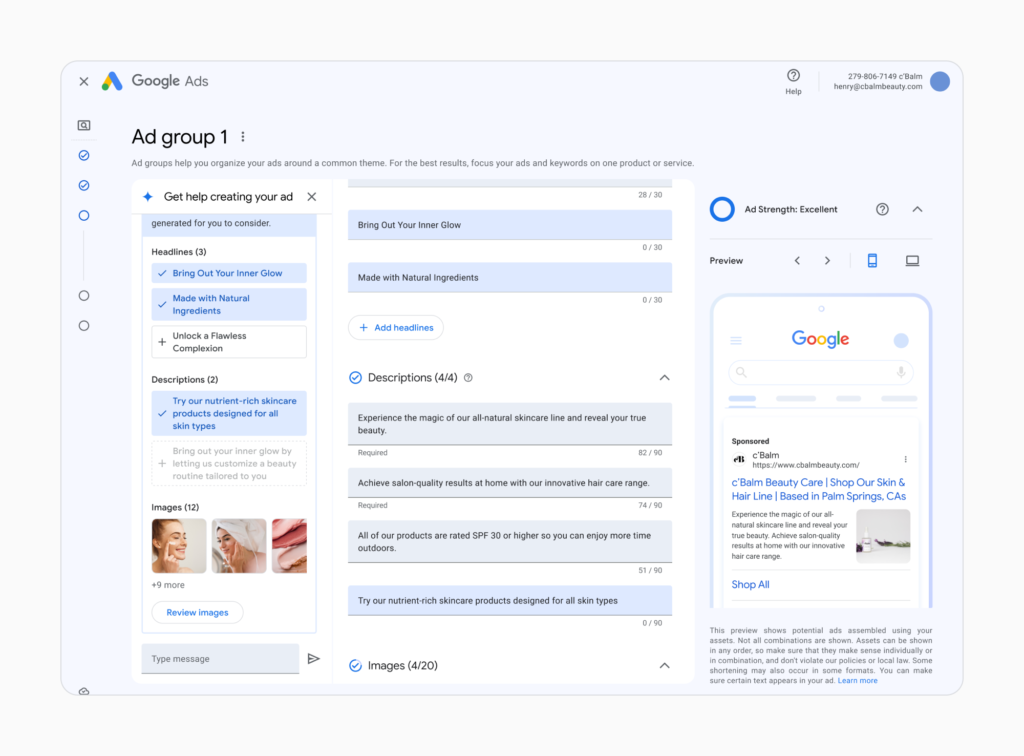Google Opens Automatically Created Assets Publicly to Boost Efficiency
Google has made the most recent improvements to the conversational experience and automatically created assets for Google Ads available to the public. More users will be able to employ AI to increase the effectiveness of marketing campaigns. The new capability is an effort toward automating the workflow for advertising. ACAs were previously restricted to marketers running English-language campaigns during open beta. The ACAs, however, are now offered in seven other languages. In the upcoming months, automatically created assets will begin utilizing generative AI for advertisers with English assets in the U.S. and U.K. Google’s goal is to assist marketers in producing more assets that are better suited to users’ search queries.
A quick look at Automatically Created Assets
Automatically created assets are an opt-in campaign-level setting. Advertisers can select this setting to generate new assets (headlines and descriptions) to be used with the ones they already submitted for responsive advertising. These materials are created based on the specific context of each advertisement, which includes the landing page, current advertisements, and the ad group’s keywords.
Benefits of automatically created assets
Performance
It improves the efficiency of responsive search advertisements (RSA) by automatically adding more headlines and descriptions.
Relevance
Consistently improve the user experience on landing pages, ad copy, and inquiry pages.
Productivity
Reduce the amount of time spent manually writing effective ad copy.

Image credit- Google
Increase in Automatically Created Assets
The extension of automatically created assets is one of the most prominent improvements. Based on the unique context of an advertisement, such as the landing page or previous advertisements, this function generates personalized headlines and descriptions. The aim is to increase the Ad Strength indicator, which measures the efficiency of ads in responsive search campaigns. Marketers can remove any ACA they feel is unsuitable for their advertising. This feature, which was first only available in English, has since been made available in seven more languages. French, Italian, Japanese, German, Portuguese, and Spanish are among them.
ACAs can boost ad relevance by matching ads and landing pages better. However, it entails handing over authority to Google’s AI. For brands with severe compliance rules or industries with heavy regulation, this might not be appropriate. This is because the company won’t have complete control over the message of the advertisement.
Read More: Google Boosts Performance Max with URL Contains Targeting Tool
Utilize ACAs to deliver better-suited search advertising.
Advertisers will have two choices to start employing automatically generated assets:
- Turn them on by using the campaign setting
- On the Recommendations page, locate the “enable automatically created assets” suggestions and simply follow the on-screen instructions to get started
Create better search campaigns with Google Ads’ conversational experience.
The most recent large language model (LLM) innovation powers the conversational experience in Google advertisements. With the use of this technology, advertisers may communicate with Google advertisements in natural language to create campaign pieces. Building search campaigns makes it possible to achieve greater results with fewer resources. All that is needed for a campaign is the advertiser’s website URL, and Google AI will generate the rest. They will receive headlines and pictures from it. Marketers can interact with AI during each session to change suggestions and approve them prior to launching the campaign. Google has won praise for saving time and inspiring fresh ideas for advertisers during beta testing now taking place in the United States and the United Kingdom. Google intends to improve these capabilities even more and send them out to more marketers in the upcoming months based on early feedback.

Image credit- Google
Google’s Ongoing Application of Generative AI
By offering a more automated and effective workflow, the new generative AI features coming to Google Ads seek to reduce the complexity of contemporary digital advertising. Advertisers should be able to quickly handle changing customer behavior and the increasing need for more individualized and successful advertising tactics thanks to these new technologies. Google’s AI-powered upgrades to its ad platform offer capabilities that might greatly speed up the production and placement of ads, making them more effective and targeted in a world that is becoming more automated.
Read More: Google Secretly Alters Ad Auctions to Boost Revenue Targets


